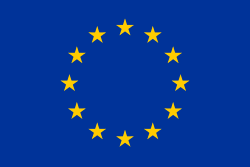Europeiska unionens publikationsbyrå
Europeiska unionens publikationsbyrå, eller enbart Publikationsbyrån,[1] är ett gemensamt förlag för Europeiska unionens institutioner. Publikationsbyrån ansvarar för att fastställa gemensamma redaktionella bestämmelser för unionens lagstiftning och andra rättsliga akter. Den ansvarar även för att distribuera Europeiska unionens officiella tidning, som ges ut varje vardag på unionens samtliga 24 officiella språk.
Trots sitt namn är Publikationsbyrån inte en byrå i rättslig mening, utan en interinstitutionell tjänsteavdelning som är förvaltningsmässigt knuten till Europeiska kommissionen.[2] Till skillnad från stora delar av övriga kommissionen har Publikationsbyrån sitt säte i Luxemburg, och inte i Bryssel, Belgien. En förvaltningskommitté leder Publikationsbyråns verksamhet.
Publikationsbyrån inrättades i samband med upprättandet av Europeiska kol- och stålgemenskapen (EKSG) 1952 med namnet ”Europeiska kol- och stålgemenskapens publikationsenhet”. De nuvarande bestämmelserna för Publikationsbyrån regleras av ett beslut av Europaparlamentet, Europeiska rådet, Europeiska unionens råd, Europeiska kommissionen, EU-domstolen, Europeiska revisionsrätten, Europeiska ekonomiska och sociala kommittén och Europeiska regionkommittén från den 26 juni 2009.[3][4]
Se även
Referenser
- ^ ”9.6 Kommissionens generaldirektorat och tjänsteavdelningar: officiella namn”. Interinstitutionella publikationshandboken. Europeiska unionens publikationsbyrå. 20 november 2023. https://publications.europa.eu/code/sv/sv-390600.htm. Läst 8 mars 2024.
- ^ ”9.5.2 Interinstitutionella tjänsteavdelningar”. Interinstitutionella publikationshandboken. Europeiska unionens publikationsbyrå. 30 januari 2024. https://publications.europa.eu/code/sv/sv-390500.htm#952. Läst 8 mars 2024.
- ^ ”Europaparlamentets, rådets, kommissionens, domstolens, revisionsrättens, Europeiska ekonomiska och sociala kommitténs och Regionkommitténs beslut av den 26 juni 2009 om organisationen och driften av Europeiska unionens publikationsbyrå (2009/496/EG, Euratom)”. EUT L 168, 30.6.2009, s. 41–47. EUR-Lex. https://eur-lex.europa.eu/legal-content/SV/TXT/PDF/?uri=CELEX:32009D0496.
- ^ ”Europaparlamentets, rådets, kommissionens, Europeiska unionens domstols, revisionsrättens, Europeiska ekonomiska och sociala kommitténs och Regionkommitténs beslut av den 29 juni 2012 om ändring av beslut 2009/496/EG, Euratom om organisationen och driften av Europeiska unionens publikationsbyrå (2012/368/EU, Euratom)”. EUT L 179, 11.7.2012, s. 15–16. EUR-Lex. https://eur-lex.europa.eu/legal-content/SV/TXT/PDF/?uri=CELEX:32012D0368.
Externa länkar
| EU-portalen – temasidan för Europeiska unionen på svenskspråkiga Wikipedia. |
Media som används på denna webbplats
The Flag of Europe is the flag and emblem of the European Union (EU) and Council of Europe (CoE). It consists of a circle of 12 golden (yellow) stars on a blue background. It was created in 1955 by the CoE and adopted by the EU, then the European Communities, in the 1980s.
The CoE and EU are distinct in membership and nature. The CoE is a 47-member international organisation dealing with human rights and rule of law, while the EU is a quasi-federal union of 27 states focused on economic integration and political cooperation. Today, the flag is mostly associated with the latter.
It was the intention of the CoE that the flag should come to represent Europe as a whole, and since its adoption the membership of the CoE covers nearly the entire continent. This is why the EU adopted the same flag. The flag has been used to represent Europe in sporting events and as a pro-democracy banner outside the Union.